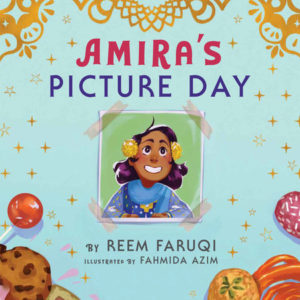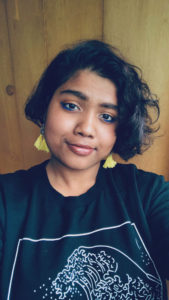Reem Faruqi and Fahmida Azim

Holiday House sat down with author Reem Faruqi and illustrator Fahmida Azim to discuss their new picture book, Amira’s Picture Day.
Please tell us about your book.

Reem Faruqi: Ramadan is over and Amira can’t wait to celebrate Eid, the Muslim holiday. Spotting the new moon, she jumps for joy because Eid is tomorrow and she gets to miss school to go to the mosque for the Eid prayer and brunch. But then she realizes that tomorrow is Picture Day at school. How will her class remember her if she’s not in the class picture? What will Amira do?
![]()
![]()
![]()
![]()
Fahmida Azim: Amira is very excited to celebrate Eid with her family. Her hands are hennaed, her treats are sorted, her dress is ironed—she’s ready! But when she discovers her school Picture Day falls on the same day as Eid, her excitement turns into distress. If she misses Picture Day, she won’t be in the class picture; and if she’s not in the picture with everyone else, it’ll be as if she was never there at all! Can she find a way to be in both places at once?

What was the inspiration behind the book?
Reem: I got the idea of writing Amira’s Picture Day because my daughter was sick on Picture Day and was devastated because she did not want to miss being in her class photo. We brought her to school for her photo and then took her back home.
I’m Muslim, and in America I always had a hard time explaining to my non-Muslim friends why I wouldn’t be at school on Eid, and I wasn’t sure when the day of Eid was until the night before! As a teacher, I always had a hard time explaining to my coworkers as well whether I would show up to work the next day or not!
So in the author’s note, I made sure to explain how we know when Eid is late the night before the holiday.
I also have a niece named Amira. She looks a little bit like the girl on the cover! Also, when I was in first grade, I remember being sick and staying home from school. I remember my mother let me go to school to drop of my birthday-card invitations, and I felt so special to come to school late in the day in my fancy clothes and frilly socks to drop off the invitations. Similarly, the character Amira feels special to come to school later in the day to drop of her goody bags.
So I put together different snippets of my life experiences for this book!
Fahmida: The inspiration for the art style of the book is heavily influenced by the children’s animated films and TV shows I grew up watching. I wanted to make this feel like the kind of Rankin/Bass–Don Bluth–Pixar holiday specials they make for folks who celebrate other holidays.
I spent the most time designing the background characters in the mosque scenes, which I was determined to make as inclusive and celebratory as possible. Much of the inspiration for the background characters came from all the fabulous and unique people I see whenever my parents take me to the Masjid for Eid.
Some of the most fun I had was with characters who identify with different youth subcultures like goths and hipsters and Instagram models. For instance, I love how some South East Asian Muslim girls have embraced modest Lolita fashion as a way to represent their faith and their love of anime all at once, so I created someone with lots of bows and laces and puffy sleeves. There’s one character who’s wearing a Palestinian thobe, and in my research I learned that the patterns on thobes are very specific to certain tribes and families, so in order not to accidentally plagiarize any family’s patterns I came up with my own.
I wanted to include everything and everyone so you have characters who wear dashikis, kameez, kurtas, abayas, lenghas, dupattas, niqabs, hijabs, big hoop earrings, nose piercings, chokers, tea dresses, glitter—as many combinations as my hands could make without overcrowding the page. In order to make these characters shine, I had to break one of the most common design rules—K.I.S.S. (keep it simple stupid)—because most of these cultures are so dedicated to intricate textile designs that minimalism would not have worked here.
What makes this book special to you? What impression do you hope it will leave with young readers?
Reem: This book is special to me because my niece is named Amira. I also captured the emotions that my daughter felt when she felt she was going to miss Picture Day.
I hope that children will feel inspired and have the courage to share their beliefs with others! It takes courage for Amira to want to share her goody bags, her culture, and her faith with her class and to show up to school in clothes that she feels different in.
Fahmida: When I first got the manuscript, I could relate to the premise a lot. There were plenty of special events I had to miss at school to celebrate Eid. Or worse, sometimes I’d miss celebrating Eid because my dad couldn’t get a day off of work. I’m not the only one who has had these experiences and I won’t be the last.
I like that this story recognizes the children who have to choose between special holidays with their family or formative memories with their friends every year. I think making kids choose between these important communities conditions them to think that their culture and essentially their “professional” life are incompatible with each other.
I hope there are kids who read this and feel seen, feel known. I also hope the adults in those kids’ lives walk away more sympathetic and become more proactive in making room for all the moments that these children find important in their world.
What inspired you to write/ illustrate, and when did you know you would become an author/illustrator?
Reem: I LOVED reading as a child. For my seventh birthday, (I think it was seven!), I got a diary as a gift. Ever since then, I’ve always kept a journal and enjoyed writing. I created this video to explain my writing journey.
Fahmida: Honestly, I don’t feel like I had much of a choice. For most of my childhood I was being pressured to become a doctor, but art felt right to me. Maybe it was because I watched so many cartoons and read so many books, but I could draw for days without getting tired—and it made me happy. However, ninety-nine percent of the life advice I got was (1) artists die destitute and (2) it’s a selfish move that would condemn my poor immigrant parents.
I was sure I was going to have to keep this a hobby, but then my sixth-grade art teacher saw potential in me and said, “One day in the future, I will google your name and the whole page will be filled with beautiful works of art. I guarantee it.” I was moved, but also scared and in denial. It was a really hard decision, but in the end, by twelfth grade when the application forms were in front of me, I chose to do what felt right.
More from the Creators!
What was your favorite book growing up?
Reem: I loved Beezus and Ramona by Beverly Cleary.
Fahmida: The Little Prince. Saint-Exupéry has a way of making you feel understood.
What is a favorite book memory from childhood?
Reem: I loved going to the library with my mother. I remember there were tall trees around the library with a bird’s nest that was so exciting for me. I love the smell of books. My grandmother had a loft with a tiny library of books and I loved going up there to read books.
Fahmida Azim: I won my school library’s paint-a-chair contest with my submission based on Hans Christian Andersen’s The Little Mermaid. It was the first thing I’d ever won.
Did you have any pets when you were growing up?
Reem: We once tried to keep a tortoise called Muddy-Too-Too, but he ran away! I had a couple of fish called Muchlee (which means “fish” in Urdu).
Fahmida: Unfortunately no—most places I’ve lived in didn’t allow pets.
Name three of your favorite authors/children’s book authors of all time.
Reem: Beverly Cleary, Enid Blyton, Roald Dahl
Fahmida: Ruth Ozeki, Arundhati Roy, Octavia Butler
What book have you most wanted to read, but haven’t yet?
Reem: A Wrinkle in Time! I’ve heard good things about it.
Fahmida: The fact that I can’t own Victo Ngai’s 2018 limited-edition Kama Sutra Vatsyayana from the Folio Society still hurts me. She’s one of my favorite illustrators and the book itself is a gallery-worthy work of art.
On a more personal level, I’ve been trying to find English translations of the Bengali book Tomake [Yours] by Humayun Ahmed. It’s my ammu’s favorite book, the last gift she received from her best friend before leaving Bangladesh to come to America. While I can speak Bangla, I can’t read it. It’s been really difficult to find English copies of my ammu’s favorite books that I can read or Bengali copies of books I like that my ammu can read. I’m an author who can’t even share my favorite books with my own mom!
What book from your childhood changed your life? Adulthood?
Reem: Can’t think of one from childhood, but I loved Enid Blyton books for their imagination. From adulthood, I loved Interpreter of Maladies by Jhumpa Lahiri, which I read in college. It was the first time I’d really seen a Pakistani person like myself in a book! I also liked Bapsi Sidhwa, a Pakistani author.
Fahmida: This is going to sound weird. I think, in a roundabout way, Dragonology helped me realize my sexuality. When I was in middle school, I befriended a girl over our mutual love for the Dragonology books—she was obsessed with dragons. I learned to draw dragons and other monsters purely to try to impress her. It wasn’t until adulthood that I realized she was my first real Sapphic crush and that I’m in fact bisexual.
In adulthood, it wasn’t until last year or the year before that I found Arundhati Roy’s The God of Small Things. Despite being South Asian, I haven’t read a lot of South Asian authors—the only other Desis I’d read by then were Rupi Kaur and Jhumpa Lahiri. The God of Small Things broke my heart, but it also gave me a language to describe a specific angst I’ve felt specific to my heritage and experience that I hadn’t seen expressed before.
Who is your favorite children’s book character and why?
Reem: I would say Ramona from Beverly Cleary or Matilda from Roald Dahl. They both were smart and mischievous.
Fahmida: Roald Dahl’s Matilda. She was my favorite because her story reconfirmed to me something I always suspected—that respect for authority has to be earned, not given.
If you could live in any book, which would it be?
Reem: I would want to be in Enid Blyton’s Faraway Tree series or her boarding-school series at St. Clare’s. It sounded fun and full of imagination!
The Book of Abarat by Clive Barker speaks to me. It’s vibrant and garish yet gothic in its gory details. Most important, each island in Abarat stands for a different time of day. As someone who hates mornings, it would please me to be able to choose what hours I’d most prefer to exist in.
If you could have a magical talent, what would it be?
Reem: I would love to be able to fly.
Fahmida: Telekinesis. It’s a multipurpose skill I can use for cleaning my room, pulling pranks, dodging bullets, and making myself fly through the air.
What is your favorite food?
Reem: Dessert with chocolate! I love Ferrero Rocher chocolate or Kit Kat or Nutella. I also love French fries.
Fahmida: It’s between Niharibone curry] and late-night curly fries.
Has it changed since childhood?
Reem: Nope! I loved Charlie and the Chocolate Factory because of the . . . chocolate!
Fahmida: I think when I was a kid I wouldn’t have been able to tell you what my favorite food was. But I know I was embarrassed to say anything my mom makes, because she makes Bengali food and no one in my class ever knew what that was. Any time I’d bring Indian/Bengali snacks for the class, they’d look confused or wouldn’t try it or worse—they’d try it and spit it out. So little-kid me would’ve told you my favorite food was ice cream sandwiches (a food that’s universally beloved and understood, ha ha). Thankfully, as I’ve grown I’ve gotten more confident about liking things no one else has ever heard of.
What food did you hate growing up but came to love in adulthood?
Reem: I didn’t like to eat dates as a child, but now I do.
I also love broccoli but don’t remember having it as a child.
Fahmida: Oh I absolutely hated fish—which was apparently unheard of from a Bengali person. But my parents still tried very hard to get me to eat fish. I’m not saying it worked, but their efforts helped me find fish that I could like and enjoy. These days fish only bothers me when it’s particularly stinky, but I can confidently say I love sushi and fish ‘n chips.
Who was your hero growing up? Who is it now?
Reem: I don’t know who it was growing up, but I say grandparents are very special to me at any age.
Fahmida: I was briefly famous in my school for not having a hero. We had an assignment in sixth-grade art class to make clay figures of our role models, but I honestly couldn’t find one. There was no one I could point to and say, “That’s who I want to be!” So instead, I convinced my teacher to let me do something ten times harder than the original assignment—make a gigantic blue butterfly statue that towered over all my other classmates’ so-called hero figures.
As an adult, the further I got in my art education, the more I craved someone else like me in my field to look up to. Someone who could relate to similar challenges, who has done this before, so I could look up and know it’s possible. I found such a person in Amrita Sher-Gil, a bisexual Hungarian-Indian painter from the early twentieth century. She lived a short, but glorious life. She trained in elite European ateliers and made a name for herself, just like the Impressionist masters I’d grown up learning about. In her lifetime she was never fully accepted in European art circles or in the Indian art establishment, yet today she is celebrated as one the greatest artists of twentieth-century India. In the West, she’s more colloquially known as “The Frida Kahlo of India,” though to me she’s simply “The Amrita Sher-Gil.” My parents would have preferred I found influence from the Tagore brothers, since they created the classical Bengal School of Art—but no. I found a hero in the mixed-race gay atheist woman who painted nude self-portraits and died young from a botched abortion.
About Reem Faruqi
Reem Faraqui is an acclaimed children’s books author. Her debut picture book, Lailah’s Lunchbox, was named an ALA Notable Book and a Notable Social Studies Trade Book for Young People and was selected for the International Literary Association’s Children’s Choices reading list. Reem’s first book with Holiday House is Amira’s Picture Day, illustrated by Fahmida Azim. Reem immigrated from Abu Dhabi, in the United Arab Emirates, to Peachtree City, Georgia, when she was thirteen years old. She now lives in Atlanta with her children.
About Fahmida Azim
Fahmida Azim is an illustrator and storyteller whose work has appeared in the New York Times and the Dallas News. Born in Bangladesh, Fahmida immigrated to Virginia as a child and later graduated from Virginia Commonwealth University School of the Arts (VCUarts). She currently lives in Seattle.
View all Featured Artists


